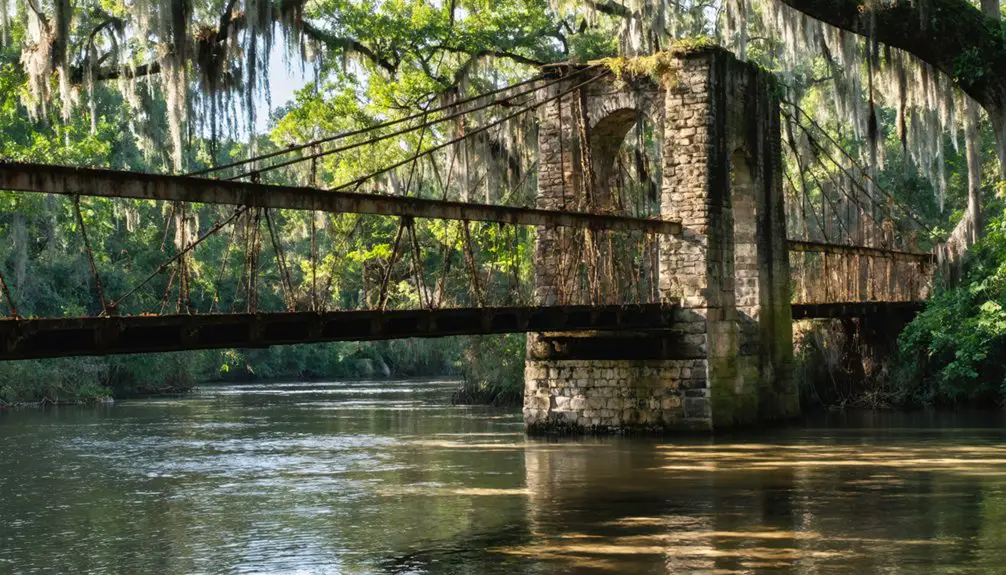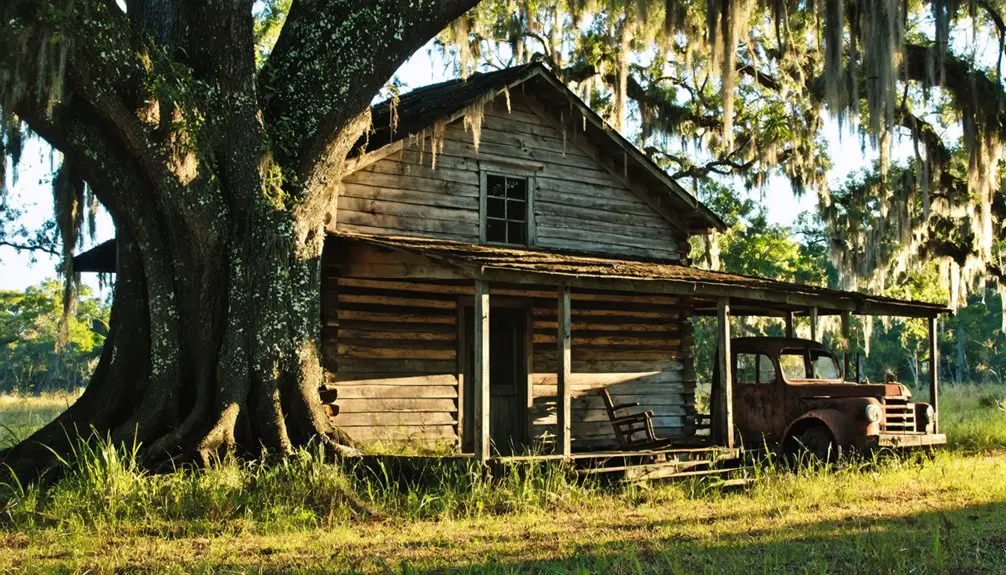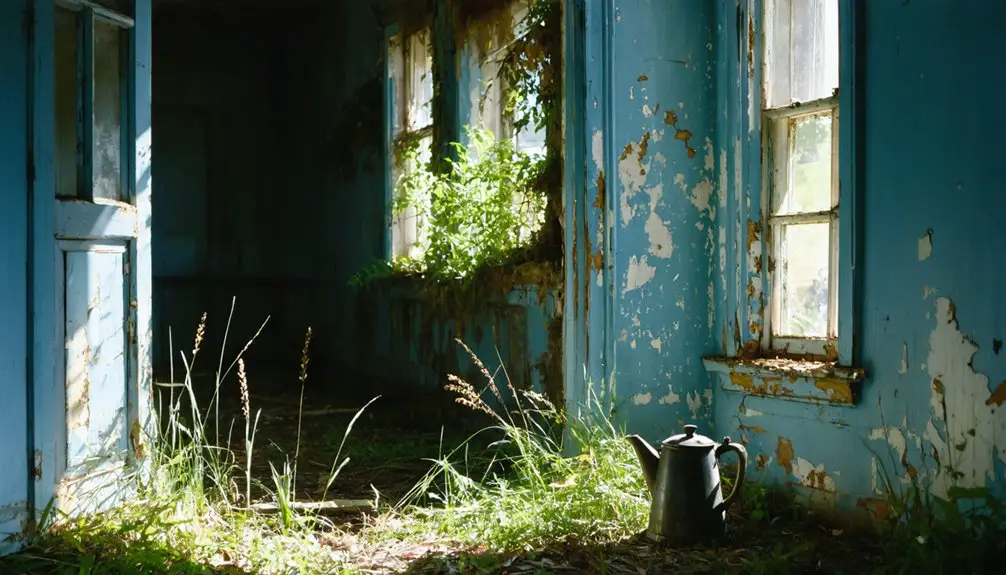You’ll find Leno’s ghost town ruins at O’Leno State Park along Florida’s Santa Fe River, where a thriving mill settlement operated from 1876 to the early 1900s. Originally named “Keno,” this frontier town changed its name for postal service approval and grew into a bustling hub with grist mills, cotton gins, and Florida’s first telegraph line. When the South Florida and Western Railroad bypassed Leno in 1894, the town’s decline led to fascinating stories of pioneer perseverance.
Key Takeaways
- Leno was a bustling mill town along Florida’s Santa Fe River that declined after being bypassed by the railroad in 1894.
- The town featured six cotton gins, multiple mills, a post office, hotel, and general store during its peak period.
- Originally named “Keno,” the settlement changed to “Leno” in 1876 and later became known as O’Leno.
- The abandoned town site was transformed into O’Leno State Park in 1935 by the Civilian Conservation Corps.
- Two historic rock dams and original stonework structures remain visible today, preserving remnants of the former settlement.
From Keno to Leno: The Birth of a Pioneer Settlement
While many pioneer settlements in Florida emerged from military outposts or trading posts, Leno’s origins trace back to a mid-1800s settlement along the Santa Fe River that initially bore the name “Keno.”
The town’s original moniker came from a popular gambling game of the era, but when locals attempted to establish a post office in 1876, federal authorities rejected the name due to its gambling associations.
You’ll find that this settlement evolution reflected the changing values of frontier America.
After the post office rejection, residents modified the name to “Leno,” which later evolved into “Old Leno” and finally “O’Leno.”
From gambling roots to postal propriety, the town’s name transformed from Keno to Leno, settling finally as O’Leno.
Despite the name changes, the settlement maintained its significance as an essential crossing point on the Santa Fe River, where people gathered for both commerce and recreation, even after the town’s eventual abandonment.
Like many early settlers who arrived by mule-drawn wagons, the town’s first residents brought with them hopes of establishing new lives in Florida’s frontier.
The bustling town supported various industries including two grist mills that served the local agricultural community.
Life Along the Santa Fe River
As you explore the rich history of Leno in the late 1800s, you’ll find settlers strategically positioned their homes and businesses along the Santa Fe River‘s natural limestone banks to harness its water power for grist and lumber mills.
During this period, you’d have seen flatboats and small vessels transporting goods up and down the river between Leno and neighboring settlements, establishing essential trade networks in North Central Florida. The river’s clear alkaline water supported dense vegetation growth typical of calcareous streams in the region.
You can still spot traces of the old swimming holes and recreation areas where Leno’s residents once gathered to escape Florida’s heat, particularly near the dramatic river disappearance at what’s now O’Leno State Park.
River-Powered Mill Operations
During the 1860s, the Santa Fe River powered Leno’s essential grist and sawmills through an ingenious system of rock dams and water wheels. The river technology relied on strategically placed stone dams that diverted water flow to generate mechanical energy for milling operations. These mills were critical until the area became a ghost town in the 1890s.
The mill architecture incorporated locally quarried stone, creating a sustainable infrastructure that served the region’s agricultural and lumber processing needs. The town thrived with six cotton gins operating at its peak.
- Two rock dams remain visible today, showcasing the innovative engineering of early settlers
- Recovered grindstones and milling machinery demonstrate the sophisticated operations
- Mill workers adapted to natural river conditions, building channels for ideal water flow
- Local stone construction minimized external material needs while maximizing efficiency
This hydropower system sustained Leno’s economy until railroads bypassed the town, marking the end of its river-powered industrial era.
Early Settlements and Trade
The mid-1800s marked Leno’s emergence as a strategic settlement along the Santa Fe River, where nature’s engineering created a remarkable underground passage. Originally named Keno, this settlement capitalized on ancient trade routes first carved by indigenous peoples like the Apalachee and Timucua.
You’ll find Leno’s story intertwined with the Old Bellamy Road, a crucial artery connecting St. Augustine to Pensacola. This federally funded route followed earlier Spanish mission trails, drawing settlers to the natural land bridge where the Santa Fe River disappears beneath the earth. The road’s construction by John Bellamy in 1824 transformed the region’s accessibility.
The town’s position made it a natural hub for travelers and traders, with the telegraph line later reinforcing its significance in regional communications. This convergence of water, road, and communication routes transformed Leno into a vibrant trading post until the railroad’s bypass in 1896 sealed its fate.
Swimming and Recreation Spots
While the Santa Fe River vanishes beneath O’Leno State Park‘s limestone bedrock, its course creates a necklace of pristine swimming holes and recreation spots that have drawn visitors since the late 1800s. The area features rustic architecture constructed during the 1930s by the Civilian Conservation Corps.
You’ll discover a series of springs perfect for exploration, each offering unique recreational activities along this historic waterway. The consistently 72-degree water temperature creates ideal swimming conditions year-round.
- Poe Spring, just 1.9 miles downstream from O’Leno, provides invigorating swimming and modern facilities
- The intimate Jonathan Spring lets you relax in shallow, cool waters beneath a canopy of hardwoods
- Rum Island Spring showcases the dramatic contrast between clear spring and tannin-colored river waters
- River Rise’s circular pool marks where the Santa Fe dramatically resurfaces after its three-mile underground journey
Whether you’re paddling the 26-mile trail, swimming in spring-fed waters, or exploring limestone outcrops, the river’s recreational opportunities connect you to a landscape that’s shaped Florida’s history.
Telegraph Tales: Florida’s First Connection
When Florida’s first telegraph line connected to the outside world in the mid-1800s, it passed directly through Leno, establishing the town as an essential early communication hub.
You’ll find that this technological milestone transformed Leno into a significant link between Florida’s interior settlements and distant markets, building upon the area’s existing importance as a transportation nexus. Today, visitors can explore the Sante Fe River where this historic town once thrived.
The telegraph’s presence, while groundbreaking for its time, couldn’t prevent Leno’s eventual decline after the railroad bypassed the town in 1896, proving that even revolutionary communication technology needed railway connections to sustain a community’s growth.
Historic Telegraph Path
Laying groundwork for Florida’s first major communication network, telegraph lines began connecting the state’s settlements in 1866 after the state government granted exclusive commercial rights to ambitious investors.
The telegraph’s significance transformed Florida’s economic landscape, revolutionizing how you’d conduct business and communicate across vast distances. The International Ocean Telegraph established vital communication links between Key West and Cuba, marking a significant milestone in Florida’s connectivity.
The Historic Telegraph Path’s communication evolution brought unprecedented connectivity:
- Followed natural corridors and historic trails, including the Old Spanish Trail
- Enabled rapid transmission of freight orders and market reports for citrus and phosphate industries
- Supported Florida East Coast Railway expansion through improved coordination
- Served as a critical emergency communication system during natural disasters
This essential infrastructure closely aligned with rail lines and future highways, creating lasting transportation corridors that would shape Florida’s development for generations to come.
First Wire’s Local Impact
As Florida’s first major telegraph line carved its path through the wilderness in 1866, the small settlement of Leno emerged as a pivotal node in the state’s nascent communication network.
The telegraph significance transformed Leno’s local economy, drawing settlers and workers while facilitating faster business transactions along the Santa Fe River.
You’ll find that this communication evolution brought unprecedented connectivity to the region’s mills and merchants, marking Florida’s first step toward modern telecommunications.
The wire’s path strategically followed ancient trails and the historic Bellamy Road, reinforcing established trade routes.
While Leno’s prominence proved temporary – eventually succumbing to the railroad’s bypass in 1896 – its role in Florida’s technological advancement left an indelible mark.
Today, you can trace this heritage through artifacts preserved in O’Leno State Park.
The Bustling Mill Town Era

During the post-Civil War era of the mid-1800s, Leno emerged as a thriving industrial hub powered by the Santa Fe River’s steady flow.
You’d find settlement dynamics at play as the town capitalized on its strategic location at a natural land bridge crossing, where multiple transportation routes converged.
The town’s community resilience manifested through its diverse economic infrastructure:
- Two grist mills and a sawmill operated using hydropower from rock dams
- Six cotton gins processed the region’s agricultural bounty
- A post office, hotel, and doctor’s office served residents’ daily needs
- A general store and stables supported both travelers and locals
You could witness Leno’s prosperity in its self-sustaining economy, where water-powered industries processed local cotton and timber, while supporting businesses created a complete commercial ecosystem serving the surrounding agricultural community.
When the Railroad Passed By
When the South Florida and Western Railroad rerouted its line through Fort White instead of Leno in 1894, you’d have witnessed the immediate economic devastation of this once-thriving mill town.
You could’ve seen businesses shuttering and families departing en masse as Leno’s commercial lifeline was effectively severed, while Fort White experienced rapid growth from its newfound rail connectivity.
Railroad’s Economic Impact
The arrival of railroads in Florida during the late 1800s transformed the state’s economic landscape by connecting isolated farming communities to lucrative northern markets.
Railroad expansion catalyzed unprecedented economic growth, revolutionizing how you’d transport goods and conduct business across the region.
Key impacts of railroad development included:
- Creation of new trade routes that enabled farmers to ship citrus and celery before spoilage
- Integration of Florida’s markets with national and international commerce networks
- Private investment from railroad magnates that generated significant economic multiplier effects
- Development of tourism infrastructure, including luxury hotels and resorts
For every dollar invested in rail infrastructure, you’d see $2.50 in economic activity generated throughout related industries.
This transformation helped pull Florida from post-Civil War debt into a thriving commercial hub, fundamentally reshaping the state’s economic destiny.
Mass Population Exodus
Following the Suwannee and Florida Railroad’s decision to bypass Leno in 1894-1896, you’d witness a swift and devastating population exodus that transformed this once-thriving settlement into a ghost town.
The population decline was immediate and thorough. You’d see families and businesses relocating to nearby railroad-connected towns, seeking better economic opportunities.
The town’s essential services – the post office, hotel, and mills – couldn’t survive these economic shifts. What was once a bustling community along the Santa Fe River became known as “Old Leno” by former residents who’d been forced to abandon their homes.
Fort White’s Rise
While Leno faced its demise, neighboring Fort White emerged as a prime example of how railroad access could transform a rural settlement into a bustling commercial center.
As rail lines pushed through Florida’s wilderness in the late 1850s, Fort White’s strategic position made it a crucial hub connecting major regional towns. You’ll find that pioneer agriculture and commercial ventures thrived as the town gained reliable transportation infrastructure.
- Cotton farmers and orange grove owners could now ship their harvests to distant markets
- Phosphate mining operations expanded with newfound ability to transport heavy loads
- Turpentine collection became more profitable with efficient distribution channels
The town’s population swelled to 2,000 as railroad infrastructure attracted workers and merchants.
The railroad’s arrival marked Fort White’s transformation from backwoods settlement to prosperous commercial center, demonstrating the profound impact of rail connectivity on Florida’s interior development.
CCC’s Transformation of a Ghost Town
During the depths of the Great Depression in 1935, CCC Company 418 established Camp P-67 at the abandoned town of Leno, marking the beginning of a remarkable transformation from ghost town to state park.
You’ll find the CCC’s contributions shaped every aspect of what would become O’Leno State Park, from rustic log pavilions to stone cabins that still stand today.
The workers enhanced park accessibility by constructing a signature swinging bridge over the Santa Fe River, while developing an extensive network of hiking trails through hardwood swamps and sandhills.
They preserved remnants of Leno’s industrial past, incorporating old mill machinery into exhibits, and built educational facilities including a fire tower and rock amphitheater.
Engineering Marvel: The Suspension Bridge

Among the CCC’s most impressive achievements at O’Leno State Park stands the iconic suspension bridge spanning the Santa Fe River. Built in the 1930s using period engineering techniques, this structure exemplifies the CCC’s commitment to blending functionality with natural aesthetics.
You’ll find this engineering marvel strategically positioned where the Santa Fe River flows above ground before disappearing underground, creating an essential connection for park visitors.
The bridge’s design features:
The suspension bridge’s thoughtful construction marries practical design elements with sustainable features, showcasing the CCC’s engineering excellence in park infrastructure.
- Suspended cables between towers supporting a pedestrian deck
- Durable materials chosen for wilderness conditions
- Simple maintenance requirements suited for park operations
- Integration with the park’s extensive trail system
While currently closed due to Hurricane Ian damage, this historic bridge remains a reflection of Depression-era ingenuity and the CCC’s lasting impact on Florida’s recreational infrastructure.
Natural Wonders of O’Leno State Park
As Florida’s geological forces carved the landscape over millennia, O’Leno State Park emerged as a showcase of the state’s most distinctive natural phenomena.
You’ll discover the Santa Fe River‘s dramatic disappearance into karst formations at River Sink, only to resurface three miles away at River Rise Preserve. This natural land bridge has served as a crossing point for over 7,000 years.
The park’s 18 distinct wildlife habitats range from hardwood hammocks to river swamps, creating sanctuaries for diverse species.
You’ll spot white-tailed deer, gopher tortoises, and rare birds like the Mississippi Kite and Summer Tanager. The riparian zones along the Santa Fe River provide prime viewing opportunities, while extensive trail networks let you explore these natural wonders at your own pace.
Preserving Pioneer Heritage

The preservation of Leno’s pioneer heritage began decisively in 1934 when the Civilian Conservation Corps (CCC) established a transformative presence at the former ghost town site.
In 1934, the CCC breathed new life into Leno’s abandoned pioneer settlement, beginning a vital era of historical preservation.
Through careful restoration and development, they’ve created a living museum that continues to educate visitors about Florida’s pioneer history.
You’ll find numerous preserved elements that showcase Leno’s industrial past:
- Original stonework cabins and log pavilions built by the CCC
- Machinery from historic grist and sawmills
- Rock dams and mill foundations along the Santa Fe River
- Transportation routes and the natural bridge crossing
Today, heritage education thrives through community involvement, with local history groups and volunteers maintaining exhibits and leading interpretive tours.
You can experience pioneer life through hands-on demonstrations, guided hikes, and special events that bring the 19th-century settlement’s story to life.
The Legacy of Camp O’Leno
Built on the foundations of the former mill town, Camp O’Leno emerged in the 1930s through collaborative efforts of the Civilian Conservation Corps (CCC) and Works Progress Administration.
You’ll find their remarkable CCC contributions throughout the grounds, from rustic stonework cabins to cypress log pavilions that exemplify the distinctive “parkitecture” of the era.
The site’s architectural heritage lives on through preserved structures you can still experience today. The CCC’s original buildings, including a recreation hall and dining facility, now serve as rentable venues for your special events.
A log cabin fort houses a museum chronicling the CCC’s essential role in Florida’s conservation history. Along the Santa Fe River, you’ll discover how their vision of combining forestry training with environmental preservation created an enduring legacy that continues to shape O’Leno State Park.
Frequently Asked Questions
What Indigenous Tribes Originally Inhabited the Leno Area Before European Settlement?
Through thick and thin, you’ll find the Alachua Seminoles were the primary inhabitants, having deep tribal history in the area. Their indigenous culture stemmed from Creek migrants who settled around Paynes Prairie.
How Many Residents Lived in Leno During Its Peak Population?
You’ll find Leno’s demographics are sparsely documented, but historical records suggest the town reached its peak population of several hundred residents before its decline in the late 19th century.
Were There Any Notable Crimes or Outlaws in Leno’s History?
You won’t find notable outlaws or significant crimes in Leno’s history. Despite its gambling-inspired original name “Keno,” historical records show no evidence of criminal activity during the town’s existence.
What Happened to the Original Buildings and Structures After Abandonment?
Like autumn leaves scattering in the wind, abandoned structures quickly vanished after 1890 when residents left. You’ll find only stone dams and mill artifacts preserved within today’s O’Leno State Park.
Did Any Descendants of Original Leno Settlers Return to Live Nearby?
You won’t find documented cases of descendants returning to settle near old Leno, though descendant stories and family reunions in surrounding towns like Mikesville and Fort White suggest families stayed regionally connected.
References
- https://www.exploresouthernhistory.com/oleno.html
- https://southofseeds.com/blog/2022/3/24/oleno-state-park/river-trail
- https://www.instagram.com/friendsofoleno/p/CYr7YaNLk1s/?locale=fr_CA
- https://www.floridastateparks.org/sites/default/files/media/file/rrp-brochure.pdf
- https://www.floridastateparks.org/parks-and-trails/oleno-state-park/history
- https://www.florida-backroads-travel.com/florida-pioneer-heritage-and-genealogy.html
- https://panhandlepioneer.org
- https://floridaspringsinstitute.org/wp-content/uploads/2021/07/Lower-Santa-Fe-River-Phase-1_Final1.pdf
- https://plants.ifas.ufl.edu/overview-of-florida-waters/waterbody-types/rivers/
- https://www.alachuacounty.us/Depts/epd/WaterResources/WaterData/Report Documents/PFS 1314-03 FINAL Technical Report 20160531 ER edits



